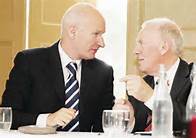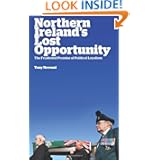DEMOCRACY???
I have been meaning to get this out of my system for some time now. My reluctance has been how to do it without it being interpreted and used as justification for further actions detrimental to working class unionists.
Every unionist reacts when Sinn Fein presume to lecture them on democracy and how the vote to only fly the union flag over the City hall on designated days was a democratic vote.
 This from a party whose members were responsible for bombing and shooting their way through four decades because they did not accept the will of the democratic majority to govern us.
This from a party whose members were responsible for bombing and shooting their way through four decades because they did not accept the will of the democratic majority to govern us.
As for the Alliance party. It was their former leader, John Alderdice in his guise as chairman of the IMC who recommended that PUP funding be removed. This recommendation was being made because of the alleged actions of the UVF – actions that have since been attributed to UVF members that were acting as agents of the state. This can only lead to the conclusion that the state did not want the PUP to develop and in fact was instrumental in its demise. Working class unionists were denied a voice and future development as a result.
The decision to change when the flag flies over the City Hall was undoubtedly part of a message that Sinn Fein wanted to send to its constituents and detractors, that it was another step closer to its primary objective of uniting Ireland. Bear in mind that the initial proposal was the flag not be flown at all.
Elected unionists, particularly the DUP chose to try and exploit the Sinn Fein proposal to remove the union flag when the alliance indicated that they would propose the alternative to fly the flag only on designated days.
Peter Robinson saw this as an opportunity to win his Westminster seat back from the Alliance’s Naomi Long by exploiting working class unionist emotions. Instead of negotiating for a different outcome to the vote, or accepting the likely outcome and preparing his constituency for it; he chose to whip up emotions and create a monster he could not control. This is not a new scenario for us, many people found themselves in Long Kesh after emotions had been heightened by unionist politicians throughout the four decades of violence from Irish nationalists masquerading as republicans.
 Unfortunately all kinds of nefarious cretins have chosen to crawl out of the woodwork to exploit working class unionists’ emotions over what is now known as the ‘flag issue’, from anti-agreement unionists to the BNP and National Front. Mysterious and anonymous loyalists materialised on social websites on the internet, organising all kinds of confrontational protests to the detriment of working class unionists; to the degree that I was convinced the source might be Connolly House or Sevastopol Street. Given the locations and some of the characters, I am more inclined to be of the view it may be the work of the state or its sinister elements which damaged the PUP.
Unfortunately all kinds of nefarious cretins have chosen to crawl out of the woodwork to exploit working class unionists’ emotions over what is now known as the ‘flag issue’, from anti-agreement unionists to the BNP and National Front. Mysterious and anonymous loyalists materialised on social websites on the internet, organising all kinds of confrontational protests to the detriment of working class unionists; to the degree that I was convinced the source might be Connolly House or Sevastopol Street. Given the locations and some of the characters, I am more inclined to be of the view it may be the work of the state or its sinister elements which damaged the PUP.
The PUP’s demise revisited this time with the intent to discredit and demonise all of the unionist working class.
Our opinion, when the PIRA ceasefire was called, was one of having Sinn Fein appear as reasonable statesmen-like ‘pursuers of peace’ whilst loyalist paramilitaries embarked on sectarian violence, appears to be re-emerging in a different guise.
Someone somewhere is being facilitated in projecting working class unionists in the most negative light.
 All the elected unionists had to do was predict the outcome of the vote. Prepare their constituents for it by turning it completely around.
All the elected unionists had to do was predict the outcome of the vote. Prepare their constituents for it by turning it completely around.
I for one could never have seen the day that Sinn Fein would vote for the union flag to be flying over the City Hall, bringing us in to line with the rest of the United Kingdom. That might justify giving Sinn Fein recognition. A notice could be raised along with the flag acknowledging that it flies with their consent.
A respectful dignified rally could be organised to witness each raising and removal of the flag and commemorate the event it is being raised for. Perhaps Sinn Fein could be persuaded to extend this vote to all councils including Newry.
Most of these would make life difficult for Sinn Fein with their own constituents and dissidents but rather than pursue those who pose a threat, the DUP opted for what they saw as the easy target, the Alliance party.
If any of them were genuine about the Good Friday agreement then instead of the DUP and Sinn Fein carving the place along their respective power lines they would seek to help ease each other’s constituents into the shared future envisaged in the Agreement that was voted for. Perhaps we need a reminder that the DUP don’t acknowledge the GFA – they refer to the Hillsborough Agreement. An agreement at which, they, the UUP, Sinn Fein and the SDLP opted to breach the GFA by ending the Civic Forum and introducing bodies like the HET and IMC etc.
Until the referendums North and South to support the GFA, Sinn Fein never recognised Northern Ireland as a democratic state or the republic for that matter. Post referendums they appear to give the impression that they now do or at least are prepared to work within them to achieve their ultimate objective.
Unionists need to remind themselves that Sinn Fein have always considered Northern Ireland as a failed state. Whilst Sinn Fein want the rest of the world to see them as peaceful statesmen trying to accommodate their fellow deluded Irish Unionists. They are happy and content to see those Unionists pilloried internationally as sectarian intransigent dinosaurs.
Sinn Fein would be quite happy to see the collapse of the Stormont Assembly especially at the hands of Unionists. It re-enforces their position of a failed state where they come out of it with the credibility that they appear to have tried to make it work, but for those intransigent Unionists.
Unionist need to get wise to this and to Sinn Fein’s antagonisms. Instead of carving everything up between Sinn Fein and the DUP re-enforcing division, they need to resist the temptation to appease their own supporters. It is their opponents supporters that they actually need to appease. Unfortunately in the current scenario, the DUP decided that their opponents were Alliance and put party and votes ahead of country.
The Civic Forum was intended to act as an advisory body to the Assembly particularly on divisive issues. It was never allowed to function as envisaged and there appears to be recognition and acknowledgement that it was a mistake to dismantle it. Both Sinn Fein and the SDLP have made noises about re-establishing it. Unionists have made sounds of opposition to its return and there is a good chance that it will re-emerge as a result of the Richard Haas talks. Will it re-emerge as it was initially constituted and intended or will it be re-established as an object of abuse to be used as an excuse for not finding agreement on those issues that the DUP and Sinn Fein have already established they cannot carve up between themselves?
As it stands in this country, if democracy exists, it exists within selective parameters and interpretations that vary with time and interpretation.
I first remember questioning democracy here when Peter Robinson first won his seat to become MP for east Belfast. Peter, Bill Craig and Oliver Napier all obtained around 15000 votes each. From what I can remember Robinson had something like 10 votes more than either Craig or Napier. By my calculations though Peter Robinson may have had 10 votes more than Craig or Napier but there were at least 30000 voters in East Belfast who didn’t want Peter Robinson representing them, almost double those who had voted for him.
That for me told me that the first past the post system is inherently undemocratic.
I often heard Gusty and Davy refer to micro and macro politics but I was too wrapped up in the local micro politics of conflict transformation that was taking place here to appreciate what they were talking about.
Unfortunately whilst we bicker and fight over flags and culture, the cultural things of real value are being eroded and dismantled in the arena of macro politics.
The most disadvantaged are being pursued vigorously to reduce benefits, whilst the most advantaged receive tax cuts even though they have avoided and evaded paying taxes. Just how much of the UK is owned by the British people, likewise, how much of the republic is Irish?
The G8 and G20 may consist of elected heads of state but the interest they represent at these meetings is the interest of the rich and wealthy.
The multi-nationals who have big franchises sucking the wealth out of the country whilst avoiding paying taxes.
And why would they not, when those who govern that very country do exactly the same?
DOGS























